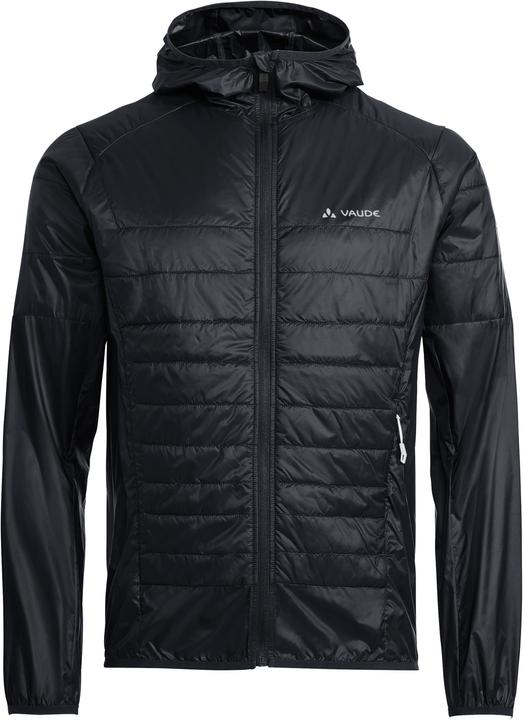

Smooth sailing until zipping time: my quibble with this lightweight cycling jacket
The Vaude Minaki Light keeps you warm in the crucial areas. It also offers good protection against biting winds – and excellent protection from the stings of a guilty conscience. Only, the zipper bears its teeth from time to time, too. That said, I am fond of my «straitjacket».
I love equipment that makes my life easier. Things that, on account of their being small, uncomplicated and practical, I always have with me. The insulated Minaki Light from Vaude aspires to be one of those go-to items. Not to be the deciding factor, but to at least make a difference when the wind threatens to chill my upper body. I’ve been cycling in this jacket for just less than a year now. During that time, it’s served me well – but occasionally brought me to the brink of despair. More on that second part later. As far as outdoor equipment is concerned, two aspects are important to me. It’s obviously got to be fit for purpose. However, the way the product is manufactured is significant, too.
Is it Vawd or Vowd?
Vaude is an outdoor equipment company based in Tettnang on Lake Constance. My colleague and fellow sports writer Patrick Bardelli and I have often wondered how to pronounce the brand name correctly. Is it meant to sound French? German? Does it matter? The answer to this is one of the reasons why the brand has found its way into my good books. Vaude is pronounced fow-duh – the German way of pronouncing v.D, the initials of the company’s founding family, the von Dewitzes. The company is still family-owned today, with the von Dewitz clan still the face of the business. Since 2009, it’s been headed up by CEO Antje von Dewitz, who had the guts to commit to sustainability before many of her counterparts did.

Since then, she and her team have accomplished remarkable things. To name a few, there was the German Sustainability Prize in 2015, the Fair Wear Foundation Best Practice Award in 2016 and achieving first place in the Ranking of Sustainability Reports in 2019. There’s also flexible working practices, a self-run company kindergarten, a 60-per-cent-female workforce, a refugee integration scheme and, as of this year, carbon neutrality. And the list goes on. I get the impression we’re dealing with someone serious here. Someone who communicates these things factually instead of launching glossy campaigns covered in green fig leaves. Vaude is eco-friendly, socially responsible and successful. But how does the plastic jacket I’m holding in my hands fit in with the company’s green trajectory?
Black jacket, green jacket
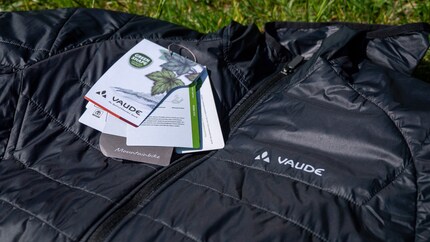
The jacket feels about as eco-friendly as a pallet of PET bottles of Coca-Cola. It’s dark, shiny and made of smooth plastic, but it comes with a smattering of different labels that alleviate any guilt. Green Shape, Green Button, Fair Wear, myclimate neutral. Together, they probably weigh almost as much as the jacket itself. I set the tags to one side for now and focus on how the Minaki fares on the road. It comes out when I’m biking or jogging in the cold or rain. It’s only insulated at the abdominal, chest and shoulder areas. In other words, the places where the wind hits a sweat-soaked jersey as you’re going downhill.
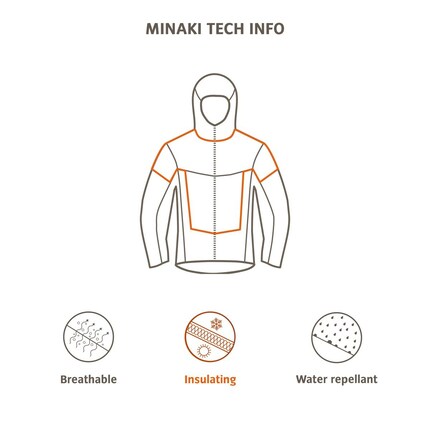
Source: Vaude
Every other part of the insulated jacket is extremely thin, breathable and water repellent. In practice, that means that after 40 minutes out in a drizzle, I’m still not completely wet. The jacket has a pleasantly snug cut, a good length and a hood which, because of the cut-out sides, doesn’t block your vision. Although it has a synthetic feel against your skin, it isn’t sticky. It’s labelled as being 80 per cent wind resistant, so it does get a tiny bit draughty. Overall, it’s pretty inconspicuous and keeps you warm without becoming a sweat box. In short, it meets my expectations. I first notice how light the jacket is as soon as I put something into the left-hand zip pocket on the back. Straight away, the additional weight drags the jacket down.
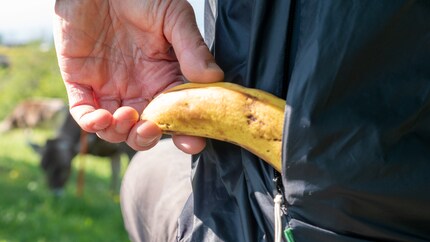
The banana benchmark and a toothy zipper
At least three bananas would fit into the pocket, but I’m looking for one in particular. According to the jacket’s product description: «It barely weighs more than a banana and takes up even less space in your backpack». It does, in fact, weigh 180 grammes. As I learn during the test weigh-in, that’s about as heavy as an average banana.
The insulated jacket does, however, share one unfavourable trait with tropical fruit. You know those unruly bananas that you just can’t peel because the skin is kind of floppy? With the jacket, it’s the zipper that keeps pushing me over the edge. It loves biting into the underlay – the fine layer of fabric behind the zip, which is meant to guard against the wind. This unfortunately tends to happen to me when the zip is at chin level, which traps me in like a kind of straitjacket. It’s sort of humbling, actually, because in this situation, the issue isn’t easily rectified.
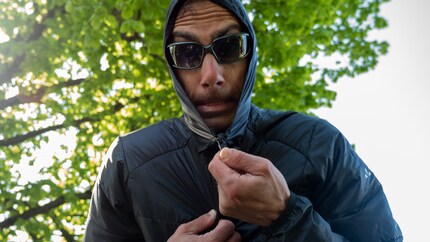
Several times, I had to violently yank the jacket over my head in order to peel it off me. The problem is familiar from classic situations such as «Help! I’m stuck in my sleeping bag» and «Dastardly bed linen – the zip is bust». When it happens right under your chin, though, the fun stops for good.
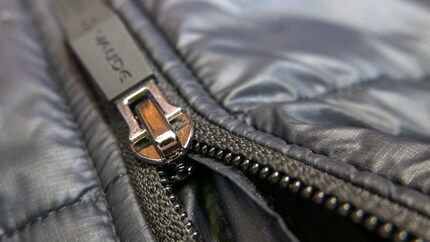
Whenever extremely thin fabric meets a zipper, danger is just around the corner. Every time I think to myself: «It’s not gonna happen again.» And then it does. It’s not fair. But fairness is to be found elsewhere.
Fairness and eco-friendly traits
I’ve dug out the discarded labels again. For a long time, there’s been a considerable discrepancy between businesses’ professed love of nature and the use of plastic and chemicals in products. Especially when it comes to outdoor goods. These days, every brand is flying the flag for sustainability. What that means in reality is often hard to understand. I’ll give it a quick shot with the Minaki Light as my example.
S-Café
- The Minaki Light is made of 100 per cent recycled material and the padding has an S-Café component. That means it contains coffee grounds, which have been specially processed and made into a quick-drying, odour-resistant material for new products.
Eco Finish
- Thanks to its «Eco Finish», the jacket is water and dirt repellent. In other words, it’s PCF-free and contains no harmful chemicals – something Vaude has been doing as standard since 2018.
Fair Wear
- Fair Wear stands for good working conditions, fair wages and the promise to continue improving both. One click reveals which Vietnamese factory manufactured my jacket. In a Fair Wear check, Vaude is identified as a «leader» with 91 points out of 100. Other sportswear brands on Fair Wear include Haglöfs (leader, 83 points) Ortovox (leader, 77 points) and Mammut (good, 59 points) among others.
Green Button and Green Shape
- Then we have the Green Button (textiles produced under particularly high social and environmental standards) and, as a sort of bonus, Green Shape. That’s the company’s own label, which aims to ensure the lifecycles of its products are as sustainable as possible.
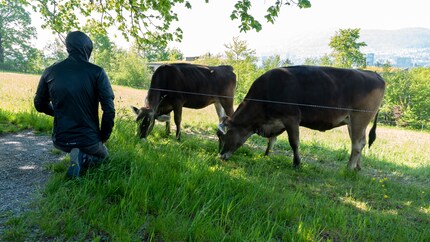
Previously unavoidable emissions such as those generated by manufacturing and transport are offset via myclimate. The deluge of labels illustrates the problem: reaching an informed opinion requires detective work. For me, the overall picture of Vaude adds up once you put the individual aspects under the microscope and piece together the evidence.
The verdict
One feeling lingers at the end of the test. I have a mostly positive view of the jacket and the brand. You can pack the Vaude Minaki Light without a second thought. It’s practically weightless, made from recycled material and is warm but airy. Only zipping and unzipping it will give you pause. The zipper issue drives me crazy sometimes. Not only that, but I’d like to be able to stow the jacket in the pocket and zip it up. The zipper isn’t designed for that, though.
I like the brand; it may not have striking PR campaigns, but that doesn’t mean it can’t pack a punch. If you value good manufacturing conditions and the environment, you’ll quickly see that the information provided on these issues isn’t as thin as the jacket. If you ask me, that’s a big fat selling point.
Simple writer and dad of two who likes to be on the move, wading through everyday family life. Juggling several balls, I'll occasionally drop one. It could be a ball, or a remark. Or both.
